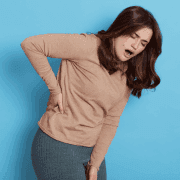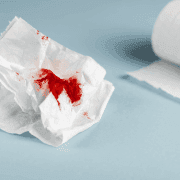Sitting All Day Wreaking Havoc? It Might Be Piles!
In This Article
Sitting All Day Wreaking Havoc? It Might Be Piles!
Winnie
Updated on May 21, 2024
Medically verified by Dr. Arya
Fact checked by Dr. Pournami

Proctology
6 min read
Are you aware that this can wreak havoc on our health in unexpected ways? One such consequence that often goes unnoticed until it becomes a painful problem is piles.
So, if you've been experiencing discomfort down there after long hours of sitting, it might be time to pay attention, as it could be piles.
Mykare Health is here to help you understand more on this matter. Let's delve deeper into what piles are, why they occur, and what you can do to prevent and manage them.
What are Piles?
Piles or haemorrhoids are enlarged and swollen veins in and around the anus and rectum. Mostly they are painful and uncomfortable causing severe pain and irritability. With age and certain health conditions, it can get worse.
In severe cases, Piles can lead to excessive anal bleeding further leading to anaemia. They can cause pain while passing stool and the person with piles may feel that the bowels are still full.
The symptoms of Piles are not serious in most cases. They are classified into four grades.
- Grade I: Inflammations are small and usually lie inside the lining of the anus. So, they are not visible. It denotes the beginning stage of Piles.
- Grade II: Compared to Grade I piles they are larger and remain inside the anus. Usually, they get pushed out during the passing of stool, but they will return to normal. Grade II becomes more complicated when it reaches Grade III.
- Grade III: They are also known as prolapsed haemorrhoids, and appear outside the anus. They usually hang from the rectum which cannot be easily re-inserted.
- Grade IV: They are large and cannot be pushed back in. They remain outside of the anus and require medical attention. Surgery is the only option when it reaches Grade IV.
Who Are At Risk of Developing Haemorrhoids
- Low fibre diet
- Severe constipation
- Pregnancy
- Straining during Bowel movements
- Overweight
Symptoms
- Swelling, redness and Itching near the anus
- Discomfort and pain in the anal area especially while sitting
- Stools with blood and Mucus
- Painful lumps around the anus
Classification of Piles
Piles are classified into different types based on their location.
- Internal Haemorrhoids - Swollen veins inside the rectum which may bleed but are not painful.
- External Haemorrhoids - They are the swollen veins around your anus and often lead to bleeding.
- Prolapsed Haemorrhoids - Both internal and External haemorrhoids can stretch and bulge outside of your anus.
 5 min read
5 min readDon't Ignore Bummy Pain: Could It Be Piles?
 7 min read
7 min readBlood In The Stool: A Sign You Shouldn’t Ignore
 5 min read
5 min readPregnancy & Piles: Taming This Discomfort
Get a Callback Now
Preventive Measures
- Include high-fibre food
High-fibre food helps to make stools softer and easier to pass and can help treat and prevent haemorrhoids.
Vegetables like Beetroot, Mushrooms, Asparagus, Spinach, Turnip, Lettuce, Pumpkin, and Broccoli are great for increasing fibre content. Whole grains, Legumes and nuts like Quinoa, Brown rice, oatmeal, Lentils, Chickpeas, Split peas, Sunflower seeds, Almonds, and Pistachios are great sources of fibre content.
Add apples, Peaches, Pears, Tangerines, Berries, and Kiwis to the diet to improve fire content. Daily fibre intake should be at least 20 to 35 grams.
Drink plenty of water
Drink at least 8 glasses of water a day. More intake of water helps in softening the stools thus avoiding constipation and straining during bowel movements. Include fruit juices and coconut water in your diet.
- Avoid long hours of sitting
Prolonged sitting can lead to intense pressure which can aggravate existing piles. Sitting on a hard chair causes more pressure.
Due to long hours of sitting the small veins around the anus get stretched out and lose their elasticity causing them to get engorged with blood. This gets converted to haemorrhoids.
To minimize this, try to keep your legs elevated while sitting. Using seat cushions and pillows is also effective in reducing pain.
- Do not Strain
Excessive straining may lead to the development of Piles. So, it's always advisable not to strain too much in the toilet.
Occasional straining is not a cause for concern but regular straining may lead to further complications. A change in diet can help soften the stools thus preventing one from straining.
- Exercise
Exercise plays a great role in reducing constipation. It helps to improve digestive health and promote regular bowel movement. Pelvic floor contraction, Deep breathing, Squats and child pose are some of the best exercises for people with Piles.
Treatments Available
- Rubber band ligation
Here the health care provider may place one or two small rubber bands along the base of internal piles to cut off its blood flow. Thus, the haemorrhoid shrinks and tumbles off soon.
This procedure can be uncomfortable and can cause bleeding. The bleeding starts 2 to 4 days after the procedure and in some cases can be severe.
- Sclerotherapy
In Sclerotherapy a chemical solution is injected into the hemorrhoidal tissue to shrink it. It is less effective than Sclerotherapy. It is mainly done in Grade I and Grade II piles. It does not provide a permanent solution.
It can only reduce the size of the haemorrhoids and reduce symptoms like bleeding, discomfort and pain. These injections need to be repeated several times.
- Coagulation
It is used to treat small- and medium-sized haemorrhoids. It has some side effects and causes discomfort. It is a non-surgical procedure which eliminates small to mid-size haemorrhoids.
Surgical Procedures
- Hemorrhoidectomy
It is one of the most effective methods to remove internal or external haemorrhoids but is also associated with a set of complications. It is usually performed in patients with grade III or grade IV piles. It is an outpatient procedure and is done under local or general anesthesia.
- Hemorrhoid stapling
This method is less painful compared to Haemorrhoidectomy but chances for recurrence are high. It is mainly done to eliminate internal haemorrhoids.
When to consult a doctor?
If you have symptoms of piles which have no improvement even after seven days or if you notice any abnormal swelling or change in your anus you should consult a doctor.
Include additional fibre in your Diet from organic products, vegetables, and entire grains like wheat. Fiber relaxes stool and makes it simpler to pass.
Drink around eight glasses of water day to day. This will forestall obstruction and the stress that causes haemorrhoids.
Work out routinely. Keeping your body moving will keep your entrails moving as well.
In case you need to make a solid discharge, don't hold it in. Stool can begin to back up, compelling you to strain when you go.



